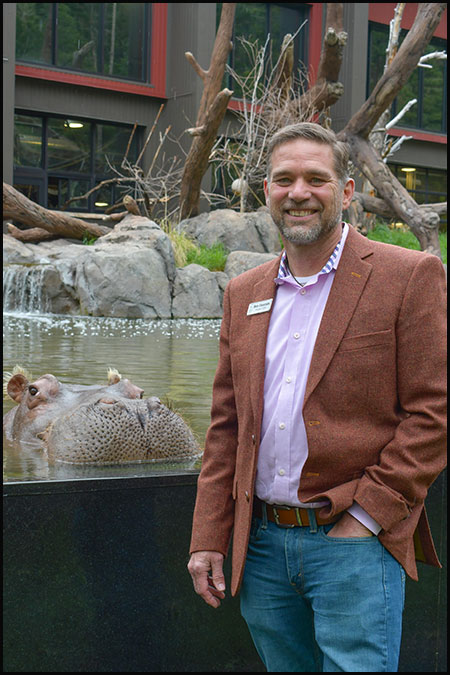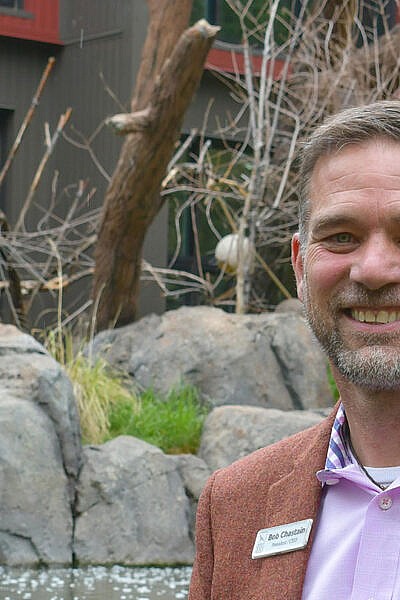
BOB CHASTAIN SET TO RETIRE IN THE ZOO’S CENTENNIAL YEAR: 2026 – After nearly 30 years at Cheyenne Mountain Zoo, and 20 years in the position of president & CEO, Bob Chastain has announced his plan to retire in 2026. Over the next two years, the CMZoo board of directors, who have been intimately involved in succession planning, will search for a new president & CEO while Chastain focuses on finalizing major Zoo renovations.
“Although I still have two years at our Zoo, I want to be transparent with our community that there are some changes coming,” said Chastain. “This organization has prioritized building bench strength in leadership and being stronger than just one person. With that in mind, we started working on succession planning pretty much immediately after I started. This next two years is the last phase of that longtime planning. Some people might have questions about my retirement, but I bet more will be curious about what’s next for the Zoo. In two years, the Zoo will be transformed in terms of animal welfare and the arrival experience for our guests.”
“Bob’s ambition and passion for conservation, community and animal care have been contagious during his tenure,” said Tia Ferguson, Cheyenne Mountain Zoo board chair. “While we’ll miss working with him closely, we know he will leave a lasting mark on the Zoo. Strong leaders and staff are in place, the Zoo is financially stable, we’re making incredible conservation progress, and major Zoo improvements are underway with the leadership of a dedicated board. We’re excited for what’s next.”
During his time at Cheyenne Mountain Zoo, Chastain has led the Zoo through exponential visitor growth, which led to growth in staff and growth in conservation funding available to the Zoo’s frontline conservation partners and projects all over the world. In 1995, when Chastain started at the Zoo, CMZoo welcomed 365,000 guests. Over the next 30 years, annual visitors grew to a height of 900,000. In response to the growing number of visitors, the Zoo limited capacity to preserve the experience. Today, the Zoo is the most visited paid attraction in the Pikes Peak region, averaging 800,000 annual visitors.
Colorado Springs’ ‘little mountain Zoo’ shed that reputation, and it grew to become a top-five ranked zoo in North America, over the years. New exhibit openings, including African Rift Valley in 2003 – with one of the first giraffe feeding experiences of its kind in the world – Rocky Mountain Wild in 2008, Encounter Africa in 2013, Australia Walkabout in 2015 and Water’s Edge: Africa in 2020, continually set higher guest expectations for a Zoo experience.
In 2021, CMZoo became only the fourth zoo in 50 years to earn a completely clean report of inspection from the Association of Zoos and Aquariums’ accreditation team. Over that four-day third-party inspection of animal care, staff well-being and culture, guest education and conservation efforts, not a single concern was reported.
“We have worked relentlessly to bring our community closer to animals, so they can make important connections that inspire them to care about wildlife and wild places,” said Chastain. “We know it’s working, because people keep coming back – and every time they visit, they’re making a direct contribution to conservation through our Quarters for Conservation (Q4C) program.”
Since launching Q4C in 2008, CMZoo visitors and members have raised more than $5 million for CMZoo’s frontline conservation partners and projects around the world – just by visiting the Zoo and having part of their admission automatically contributed to Q4C’s benefitting conservation organizations.
“I’m incredibly proud of the conservation work we’ve already done and I’m looking forward to watching that grow,” Chastain said. “Because of my personal experiences seeing the positive impact our partners are making in places like Tsavo National Park in Kenya, where the last remaining big tusker African elephants live, I have more hope than ever for the natural world.”
During his tenure, Chastain has represented CMZoo in the modern zoo and conservation professions. He has served as Chair of the Safety Committee for the Association of Zoos and Aquariums (AZA), on the AZA and World Association of Zoos and Aquariums boards and locally on the Colorado Springs Wildfire Mitigation Advisory Committee.
The Zoo plans to honor Chastain’s contributions to the Zoo and Colorado Springs when his retirement date is closer. More immediately than that, the community will start seeing progress on some of these legacy projects at the Zoo.
Last year, CMZoo started constructing a new road through the Zoo to replace the current road — which has been in place for 100 years – adjacent to African Rift Valley. The new road is taking shape now, and once the historic road is gone, the Zoo will expand its giraffe habitat into that space. In addition to creating space for new giraffe outdoor areas, it makes way for a 10,000-square foot building to house the Zoo’s iconic giraffe herd and The International Center for the Care and Conservation of Giraffe (The Giraffe Center), a new Zoo entryway, gift shop and café.
As part of The Giraffe Center opening, the Zoo will install six life-sized giraffe sculptures that guests can intermingle with. This enormous installation, known as ‘The 200 Project,’ acknowledges the more-than 200 giraffe calves born at the Zoo in support of the Giraffe Species Survival Plan. Chastain looks forward to seeing families making memories and taking photographs over the years with those sculptures, making the Zoo part of the thread of their family’s fabric.
“We recognize what vital contributions we make to conservation by creating and maintaining this special place where people come to make memories and feel inspired, but it’s so much more than the bricks in a building or the animals in our care,” said Chastain. “It’s the staff here. They make our guests’ experiences meaningful and memorable with every interaction. I will most fondly look back on creating a culture that is nothing short of magic, where we are capable of achieving the things we dream.”
Although guests can’t see it, the CMZoo staff culture is what Chastain highlights as the most important aspect of the Zoo. He has led CMZoo to build a strong staff and leadership, with training programs for emerging Zoo leaders, opportunities for staff to participate in field conservation and ways to advocate for their own conservation passion projects through the Member Conservation Vote. The strength of the staff supports the strength of the Zoo, which, as a nonprofit that doesn’t receive any tax support, is standing more financially stable than ever.
“Our financial and cultural stability is allowing us to take on a lot of improvement projects, like our current work to make upgrades to our grizzly bear habitat, which will allow us, someday soon, to care for orphaned grizzly bear cubs that need homes,” said Chastain.
In 2026, as Chastain closes his chapter of leadership at CMZoo, he will be joining in the Zoo’s 100th anniversary with a year’s worth of community celebrations, historical remembrances and exciting additions that he is confident will continue his legacy of bringing people closer than ever to our natural world.
About Cheyenne Mountain Zoo
Cheyenne Mountain Zoological Society was founded in 1926. Today, Cheyenne Mountain Zoo, America’s mountain Zoo, offers comprehensive education programs, exciting conservation efforts and truly fantastic animal experiences. In 2024, Cheyenne Mountain Zoo was voted #5 Best Zoo in North America and CMZoo’s Rocky Mountain Wild was named #2 Best Zoo Exhibit in North America by USA TODAY’s 10Best Readers’ Choice Awards. It is Cheyenne Mountain Zoo’s goal to help guests fall in love with animals and nature, and take action to protect them. Since 2008, CMZoo’s Quarters for Conservation program has raised more than $5 million dedicated to frontline conservation efforts around the world. Of the 237 zoos and aquariums accredited by the Association of Zoos and Aquariums (AZA), Cheyenne Mountain Zoo is one of just a few operating without tax support. Cheyenne Mountain Zoo depends on admissions, membership dues, special event attendance and donations for funding.

